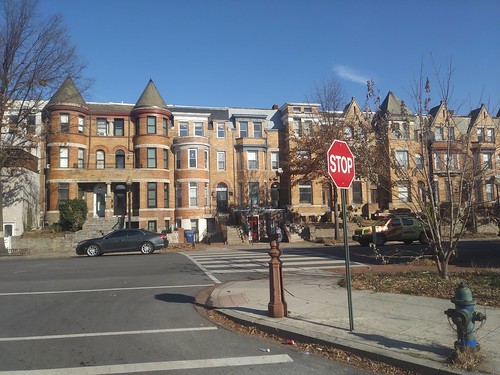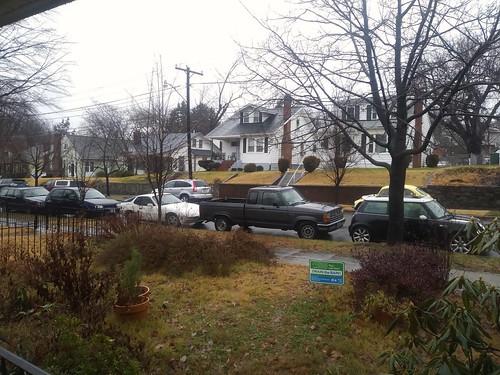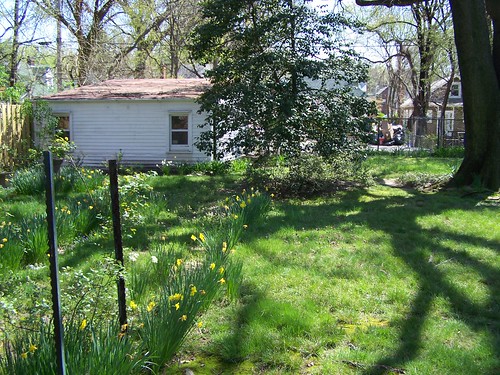Minneapolis to eliminate "single family residential zoning" classification
The City of Minneapolis, with an aim to increase the supply of affordable housing and the "lack of inventory of 'middle' housing" has voted to eliminate the single family residential zoning classification, in concert with the city's new comprehensive plan, Minneapolis 2040. The change is expected to take effect next Spring, pending review by the regional planning agency.
-- "Minneapolis, Tackling Housing Crisis and Inequity, Votes to End Single-Family Zoning," New York Times
A sign opposing the “Minneapolis 2040” plan outside a home in the Kenwood neighborhood in Minneapolis.Credit: Jenn Ackerman for The New York Times.
From the article:
In Minneapolis, the decision came as part of a sweeping plan to propel the city into the future by addressing issues like housing, racial equity and climate change. The plan, called Minneapolis 2040, drew thousands of public comments, “Don’t Bulldoze Our Neighborhoods” yard signs and a last-minute lawsuit, but ultimately passed on a 12-to-1 vote.Race and segregation embedded in single family zoning. The article and the discussion of the issue focus not just on affordability but also addressing historic patterns of segregation. Single family housing tends to be owned by people with more money and historically this meant white people. Smaller houses cost less and therefore were more affordable for people of color.
(In fact, early 20th century planning policies restricted rowhouse zones in Upper Northwest DC with the aim of keeping out African-Americans.)
 What is single family zoning. Single family zoning refers to a housing zone category that is made up of only single family houses, usually with larger yards, etc., although not necessarily because rowhouses are also single family houses.
What is single family zoning. Single family zoning refers to a housing zone category that is made up of only single family houses, usually with larger yards, etc., although not necessarily because rowhouses are also single family houses. Levittown, New York.
Usually this means that a fair amount of land is used to house comparatvely small numbers of people. In the 21st century with a much higher cost of land, such land is seen as lending itself to redevelopment for more intense housing because people are "overhoused" relative to the size of the property.
A sign in support of the zoning changes in the front yard of a duplex in the Kenwood neighborhood of Minneapolis.Credit: Jenn Ackerman for The New York Times.
Proponents of the change have been motivated by both the cost of housing and the cost of segregation.
Interestingly, there was an article in Governing Magazine recently, "Citizen Engagement Becomes Too Much," opining that public participation usually scuttles such fundamental change, especially in terms of zoning and comprehensive planning, because of hardcore opposition to substantive change.
What is middle housing? On an ownership basis, "Middle housing" is usually termed rowhouses, alley dwellings, duplexes and triplexes. For rental property, it includes small apartment buildings owned and rented out by individuals or small operators.
In the context of a city, changing "single family zoning" shouldn't be limited to making duplexes and triplexes matter of right. It should also include small apartment buildings mixed into zones that are otherwise single family, especially in rowhouse districts.

c. 1920s three-story apartment building on the 1300 block of Park Road NW, Columbia Heights abutting single family rowhouses.

Rowhouses on Florida Avenue NW. (DC has small and large rowhouses, these are large.)

Single family houses across the street.
Won't have much effect. Personally, I don't think this is going to have the kind of effect that Minneapolis desires, although there will be some change on the margins.
Affordability. In high value real estate markets, the missing middle isn't about the type of housing, but about the price of housing. In high demand markets, all housing is priced high, regardless of type.
The reason you have duplexes, rowhouses, etc. is to fit more housing units on smaller plots of land. But in a market where demand is greater than supply, housing size does(n't) matter when it comes to price, except relatively.
-- "The nature of high value ("strong") residential real estate markets," 2017
-- "The eight components of housing value," 2016
First, individual property owners likely don't have the motivation or capital to convert their properties.
Second, small developers will be motivated to take on this type of development, but it won't result in housing that is much cheaper than current market prices because:
- the cost of land isn't cheap anyway
- but will go up to take into account the build out opportunity present in adding one or two additional units
- labor costs are at current prices
- building materials costs are at current prices.
 Our backyard garage could be rebuilt as an ADU, but it would take at least 12 years to pay off.
Our backyard garage could be rebuilt as an ADU, but it would take at least 12 years to pay off.While I think there is opportunity to build many thousands of ADUs in DC, the cost of doing so is likely to be about $200,000/unit and because of the cost of capital, the average independent houseowner isn't likely to be willing to do it, without significant subsidy. And rents for an 800 s.f. ADU are likely to be at least $1,500/month and likely higher, especially near transit.
Segregation. Because the cost of housing is high relatively speaking, regardless of the size of the house, allowing houses to be converted to duplexes and triplexes likely won't have much impact on the racial make up of particular neighborhoods unless the community is already experiencing high rates of demographic change.
Mix of modern apartment building and traditional four square houses, Little Italy. Photo: Kent Sievers, Omaha World-Herald.
Omaha and integrating multi-unit housing into single family neighborhoods. Interestingly, I came across some articles in the Omaha World-Herald the other day on development trends there, and one was about a community-initiated planning effort in the neighborhood, sparked by the insertion of apartments using the rowhouse building type into what had been a single family housing district ("10th Street development galvanizes residents").
Given today's development conditions in terms of demand--most cities were built up by 1930, when the US population was 40% of what it is today--and the cost of land, labor, and materials, communities are going to need to add apartment and condominium buildings, not duplexes, triplexes, and accessory dwelling units, if they want substantive and real impact.
Figuring out how to allow for this in the context of the prevalence of single family housing zoning categories is going to be a major challenge.
Labels: affordable housing, demographics, gentrification, Growth Machine, housing market, housing policy, multi-unit housing, real estate development, segregation, urban design/placemaking, urban revitalization





8 Comments:
You've got to look at both the short term and long term.
Short term-- almost no effect.
Long term -- who knows.
For example, the "finger" people of V st NW a few years ago (basically a 5 story popup next to some very small two store row houses). Street was zoned r4 or r5 so zoning isn't an issue.
Building still has an unsold unit that may be airbnb -- that is 5 years is very strong market. Also none of the adjoining building have been turned into 5 story townhouses either -- and I suspect the majority of them have turned over since then.
Once you platt land in SFH the transactions costs of turning it over to multifamily are going to be hard. Basically makes sense when market value plunges (Logan Circle?) but if you have to acquire at market prices isn't going to work.
EXACTLY.
E.g. the DC for Responsible Development group (Chris Otten et al, I'd characterize them as anti-development) in response to a thread on this on our Takoma e-list said "there's demand for affordable housing, but developers are only building expensive studios."
The response I made isn't anything new to you, basically about today's cost of land, materials, and labor, height restrictions, opportunity costs of building smaller, etc.
Even with cheap land, it's hard to make affordable housing pencil out in strong markets.
====
But wrt Minneapolis, it's not that strong of a market where transaction costs etc. can be covered because of the high value of potential units.
cf. when I went to the Nat. Trust conference in Cleveland in 2002, I went on a tour of tax credit projects, including a number by the Famicos Foundation, a Catholic charitable organization. They did great work. As did the Cleveland Restoration Society.
But both recognized that there would be subsidy, that the cost of rehabbing property at least in the intermediate if not long term wouldn't be covered by the new appraised value of the property. But they were doing it to stabilize neighborhoods, resurrect historic properties, and/or to provide housing for people of lesser means.
unrelated:
https://www.statesman.com/news/20181214/why-beto-orourkes-254-county-strategy-flopped
So my big idea -- is the Chicago "circular" model (i.e. "The PLAN") was basically immigration/new arrival based; it broke down in the 1930s as immigration stopped.
So urban geography now is being driven more by money.
Areas go up in value, money pours in. I.e gentrification.
At some point those values reverse and the areas moves different.
Look at North dupont circle -- old gays who came in the 1970s -- that area is going downhill now as they age, too expensive to bring new residents in but not expensive enough to justify the $2M renovation .
So anything to bring that money is a good in my book.
Some negative feedback is a rising tide does not float boats of renters with no/low/fixed income.
In fact I model the YIMBYS on this. They know thanks to demographics there will be less homebuyers in 10 years. Can't count on the boomers so the only way UP is volume and up zoning. Turn that $1M house in Tacoma into a 4 bedroom condo for a total price of $1.75M. B/C you're not going to sell it for $1.75 as a SFH. Just picking on Tacoma, sorry.
Maybe the answer is restrict the up zoning to condos and not rentals but I don't know how you regulate that.
Deep points.
I am preparing a "the new blockbusting" post, not unlike stuff I've written in the past, about what's going on in my area. Since developers can buy a house for $500K or so and fully renovated, sell it for $900K they are aggressively contacting people of unrenovated homes, like us.
As I say to Suzanne, houses do need to be refreshed every few decades.
But as you point out with North Dupont Circle, there is only so much wiggle room in the economics. If the houses on our street already cost $900,000, it's not worth it, 'cause there's no way there's a market for it.
If a house needs many many hundreds of thousands for a re-do, it may not make sense.
(Rightsizing large houses is a whole other issue.)
I would say that in the core, there is more of it, and I am not so "negative" as you.
The Chicago concentric ring model isn't necessarily apt for center city Washington, Boston, SF, the inner parts of NYC, etc.
So these areas will maintain their value and attractiveness because of location.
But then again, I could be wrong.
====
I haven't ever read Park's _The City_ but I do have it on my list of items to read.
https://www.flickr.com/photos/rllayman/6605934197
Pretty doubtful on urban models but to misquote Keynes the dead hand of long ago geographers is still writing our narratives -- the Tom Tole cartoon on the plan being exhibit A.
yep. and demographers/demographics. The major cities were built when population was 40% of what it is today. More people, more demand, not enough housing.
op-ed in the Minneapolis Star Tribune doesn't argue against density, but says the various proposals in the Minneapolis comprehensive plan are misguided and won't have the outcomes that are intended.
http://www.startribune.com/editorial-counterpoint-so-let-s-talk-about-what-density-really-is/560614602/
It ran 9/18/2019
Post a Comment
<< Home